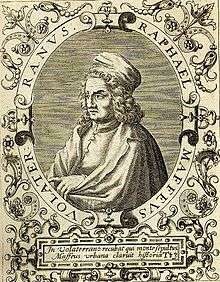Raffaello Maffei
Raffaello Maffei, OSM (17 February 1451 – 25 January 1522) was an Italian humanist, historian and theologian; and member of the Servite Order. He was a native of Volterra, Italy, and therefore is called Raphael Volaterranus or Raphael of Volterra; also Maffeus Volaterranus, or Raffaello Volterrano.

Life
From earliest youth he devoted himself to the study of letters, and in 1466 was called to Rome, with his brothers, by their father Gherardo Maffei, whom Pius II had appointed professor of law at the University of Rome, and had taken later for his secretary, a position he held also under Paul II and Sixtus IV. At Rome Raffaelo held himself aloof from the court, devoting his time to the practice of piety and to the study of philosophy of theology and of the Greek language, the latter under George of Trebizond.
In 1477, he went to Hungary with Cardinal Louis of Aragon, on the latter's mission to Matthias Corvinus. Upon his return, Raffaelo was persuaded by Gaspare da Firenze not to become a Minor Observant, as Raffaelo intended to do; whereupon he married, and established his residence at Volterra.
The remainder of his life was spent in study, in the practice of piety and of penance, and in the exercise of works of charity; in his own house, he established an accademia, in which he gave lectures on philosophy and on theology, while he founded the Clarisse monastery of Volterra. He died in the odor of sanctity; and, contrary to his desire, his brother erected to his memory a splendid monument in the church of San Lino, which Raffaello had endowed; the monument was the work of Silvio Cosini, Stagio Stagi, and Fra Giovanni Angelo Montorsoli, OSM.
Works
Among the works of Maffei are Commentariorum rerum urbanarum libri XXXVIII (Rome, 1506; Paris, 1516), an encyclopedia of all subjects known at that time, prepared with great care, but not always with the best judgment. It consists of three parts; in the first, "Geography[1]", he writes a history of the whole known world arranged by location; the second part, "Anthropology", is devoted, more especially, to the contemporaneous history of that time; the third part is devoted to "Philology" which encapsulates all of science and natural history as it was known.
This encyclopaedia was printed eight times up to 1603. The 1603 edition contains 814 folio pages. The first book consists of the table of contents and a classed index; books 2-12, geography; 13-23, lives of illustrious men, the popes occupying book 22, and the emperors book 23; 24-27, animals and plants; 28, metals, gems, stones, houses and other inanimate things; 34, de scientiis cyclicis (grammar and rhetoric); 35, de scientiis mathematicis, arithmetic, geometry, optica, catoptrica, astronomy and astrology; 36-38, Aristotelica (on the works of Aristotle).[2]
Maffei's lives of Sixtus IV, Innocent VIII, Alexander VI, and Pius III, which appear as an appendix to Platina's Vitae Pontificum, and which were also published separately (Venice, 1518), are taken from the Commentarii; in them Maffei blames unsparingly the disordered life of the Roman court.
At Volterra, he wrote a compendium of philosophy and of theology, De institutione christiana and De prima philosophia (Rome, 1518) in which he rather follows Scotus. He translated, from the Greek into Latin, the "Odyssey" of Homer, the "Oeconomics" of Xenophon, the "Gothic War" of Procopius, "Sermones et tractatus S. Basilii", some sermons of St. John of Damascus and of St. Andrew of Crete; he also wrote the "Vita B. Jacobi de Certaldo".
On the other hand, he was in epistolary communication with popes, cardinals, and other learned men. The manuscript of the work which he called "Peristromata" remained incomplete; it went to the Biblioteca Barberiniana.
Family
The elder brother of Maffei, Antonio, was involved in the conspiracy of the Pazzi. Another brother, Mario, was a man of great culture. He was nuncio to France and, later, prefect of the building of St. Peter's (1507), regent of the penitentiaries, and Bishop, first, of Aquino (1516) and then of Cavaillon, he died on 23 June 1537.
References
- Lestringant, Frank (2016-03-21). Mapping the Renaissance World: The Geographical Imagination in the Age of Discovery. ISBN 9780745683669.
-

![]()